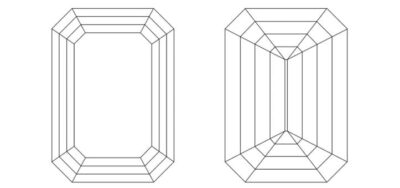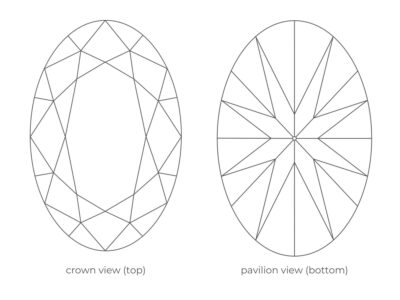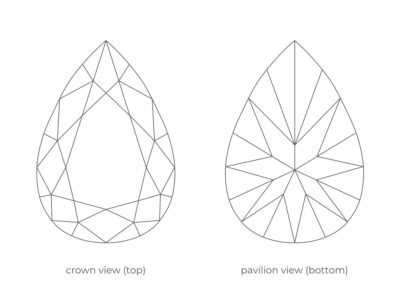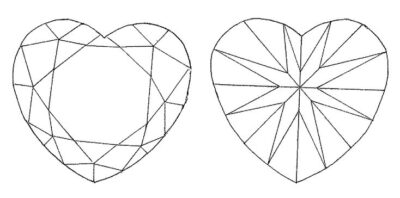ROUND BRILLIANT CUT DIAMONDS
The Round Brilliant Cut or RBC accounts for more than 75% of diamonds sold worldwide, it is by far the most popular and most sought after diamond shape available as it is the most ‘brilliant’ of all cuts. The cut consists of strategically placed facets intended to maximize the diamond’s brilliance and its overall appeal. For the Round Brilliant diamond, “Ideal Cut” will guarantee immaculate proportions, brilliance and fire. Round Brilliant diamonds are typically cut to have a total of 57 facets; 33 on facets on the crown and 24 facets on the pavilion. The relationship between the crown angles (above the girdle) and the pavilion angles (below the girdle) is complementary. A steep crown angle is complemented by a shallower pavilion angle, and vice versa. The RBC will typically have a greater diameter compared to other shapes having the same shape owing to its relatively shallow ideal depth and its symmetric shape. The popularity of the Round comes at a cost, it usually fetches a price premium of 10%-40% more than other shaped diamonds.

57 to 58 facets
PRINCESS CUT DIAMONDS
The Princess Cut is one of the most popular “fancy shaped” diamonds, its beautiful brilliance and exclusive cut makes it a favorite for engagement rings. Of all of the fancy cuts, the Princess Cut ranks closest to achieving the fire and brilliance of a Round Brilliant Diamond, making it a favorable option for a unique shape and sparkling appearance The Princess Cut has pointed corners and is traditionally a square cut (four sides of equal length); however, many Princess Cut diamonds are slightly rectangular in shape yet, this is frequently hard to detect face up. Any length-to-width ratio of 1.05 or less will appear square to the naked eye. A Princess Cut diamond should always be set with prongs to protect its four corners as they are susceptible to chipping. When selecting a color grade for your Princess Cut diamond, consider choosing an “I color” or higher as due to the cuts shallow crown angles, color may be slightly visible in its corners.

53 to 54 facets
EMERALD CUT DIAMONDS
What makes the Emerald Cut shape so unique is its crown and pavilion facets which are cut with rectangular facets also known as “step cut” that are parallel to its girdle. Although it lacks the sparkle of a Brilliant Cut diamond (diamonds cut with kite shaped and triangular facets); the Emerald Cut produces an extremely desirable “hall of mirrors effect”; which are dramatic flashes of light reflected back to the viewer’s eye as a result of the cuts interplay and reflection of dark and light planes. Due to its large open table and parallel facet arrangement, the Emerald Cut shape highlights the clarity of a diamond, therefore; it’s important to select a high clarify diamond with this cut as some clarify characteristics can be quite noticeable with the naked eye. This cutting style was originally produced for emeralds, hence its name, but eventually became extremely favored to showcase high quality and rare diamonds.

49 to 50 facets
OVAL DIAMONDS
An Oval Cut diamond emits beautiful brilliance that’s similar to a Round Brilliant Cut diamond. Because the two shapes retain similar brilliance and fire; the Oval Cut is an ultimate choice for a customer who loves the look of a Round Brilliant diamond, but wants something a bit more unique. The cuts elongated slender shape produces additional advantages; it can form the illusion of greater diamond size and the shape can also make the fingers of the wearer seem slimmer and longer, effect’s which are often desired. Though a length-to-width ration of 1.35 – 1.60 is considered the Classic Oval Cut; personal preferences and appeal will be the ultimate factor to deciding as to how narrow or wide an Oval Cut diamond will be. Oval Cut diamonds can possess some gradation of the “bow tie effect” which is a dark bow-tie shaped area visible through the table across the center width of the diamond; this effect is due to improperly cut pavilion angles. This effect cannot be determined by reviewing the diamond certificate or its dimensions, but only by visual inspection.

55 to 56 facets
BAGUETTE DIAMONDS
Named after the French word for breadstick, this slim and rectangular baguette shaped diamond is the most familiar form of step cuts. This is a popular choice for eternity and wedding rings, the baguette diamonds have a small, rectangular cut. They are also used as an accent stone to accentuate a larger stone in a diamond cluster ring or are united with similar sized round brilliant cut diamonds to create a stunning look.

14 facets
PEAR DIAMONDS
The Pear Shaped Diamond is a combination of a Marquise shape and a Round Brilliant and is one of most difficult shapes to cut. This admired and desired cut is also known as the “teardrop” for its single tapered point and rounded end. Because of its faceting arrangement, the well-proportioned Pear shaped diamond emits fantastic brilliance and fire, much like that of the Round Brilliant Cut. Cutting styles for the Pear shaped diamond can vary widely from one cutter to another; the standard number of facets is 58, but it may have an acceptable varying number of pavilion facets from 4, 6, 7, or 8. The Pear shaped diamond comes in a variety of slim to wide cuts; the optimal length-to-width ratio for a Pear shaped diamond is within the range of 1.50 – 1.70 this guarantees that the outline possesses enough length to appear proportioned and desirable and have the added benefit of making the wearer’s fingers appear longer and slimmer. The Pear shaped diamond is susceptible to the “bow-tie effect” which is a dark bow-tie shaped area visible through the table across the center width of the diamond; this effect is due to improperly cut pavilion angles. This effect cannot be determined by reviewing the diamond certificate or its dimensions, but only by visual inspection

56 to 57 facets
MARQUISE DIAMONDS
Folklore would say the marquise shape was created at the request of King Louis X1V who wanted a stone to represent the sultry smile of his mistress, the Marquise de Pompadour. The end result was a lengthened shape in a diamond cut with sharp ends. The marquise diamond is cut to exploit its carat weight, giving a superior looking stone. Marquise diamonds work beautifully as a central stone in a diamond engagement ring, or as an accent stone in diamond jewellery.

55 to 56 facets
HEART DIAMONDS
The heart is the ultimate symbol of love. The Heart shaped diamond is really a Pear shaped diamond with a cleft cut out at the top center of the diamond. This cut is considered to be a highly valued fancy cut as it is extremely hard to fashion and master as it demands a tremendous amount of skill and talent. Cutting styles for the Heart shaped diamond can vary widely from one cutter to another; the standard number of facets is 58, but it may have an acceptable varying number of pavilion facets from 4, 6, 7, or 8. The Heart shaped diamond comes also in a variety of outlines, from slim to wide. Although the length-to-width ratio of a standard Heart shaped diamond is approximately 1.00, personal preference will dictate the width of the desired outline. When choosing a Heart shaped diamond, symmetry is an extremely important characteristic; it is critical that the two halves of the outline are identical. The cleft (cut between the two lobes) should be sharp and distinct, and the wings (the sides as they curve down to the point) should have a very slightly rounded shape.

57 to 58 facets
RADIANT DIAMONDS
Designed solely for brilliance, hence its name, the Radiant Cut diamond is the first square cut to include a complete brilliant cut faceted pattern designated to both the pavilion and the crown. The Radiant Cut combines two different diamond cutting styles; the Brilliant Cut (triangular and kite shaped facets) and the Emerald Cut (step cut facets) to create a vibrant and fiery diamond. Radiant Cut diamonds can be found in either a square or rectangular outline; personal preference and desirability will always dictate the length desired. However; the rectangular Radiant Cuts are susceptible to the “bow-tie effect” which is a dark bow-tie shaped area visible through the table across the center width of the diamond; this effect is due to improperly cut pavilion angles. This effect cannot be determined by reviewing the diamond certificate or its dimensions, but only by visual inspection.

53 to 54 facets
CUSHION DIAMONDS
This Cushion Cut, also known as “pillow cut diamond” or “candlelight diamond”, has been popular for more than two centuries. The cut combines a square cut with rounded corners and larger facets to increase the diamonds overall brilliance. While this cut is generally less brilliant than Round Brilliant diamonds, this cut often emits better fire which is part of its appeal. Lately, the Cushion Cut guidelines have been improved to achieve better symmetry and proportions in order to fit contemporary standards. Cutting styles for the Cushion Cut can vary widely from one cutter to another and the ranges are almost endless. Cushion Cut diamonds are available in shapes ranging from square to rectangular; the length-to-width ratio will determine the Cushion Cut outline and what it will look like when viewed from face up. For a Cushion Cut diamond that is square, consider length-to-width ratios be.

57 to 58 facets
TRILLIANT DIAMONDS
If you appreciate bold and dramatic jewellery, then the trilliant diamond may be the perfect cut for you. Created in the 1970’s in Amsterdam, trilliant diamonds vary between traditional triangular shapes with pointed corners to a more rounded shape. A unique and intriguing diamond shape, the trilliant diamond is rarely used as a central stone in diamond jewellery but creates an irresistible accent stone for a round brilliant diamond solitaire.

40 to 41 Facets
ASSCHER CUT
The Asscher Cut, also referred to as the “Square Emerald Cut”, was first produced by the Asscher Brothers in Holland in 1902. The Asscher Cut has cropped corners; however, because of the cuts square shape and facet arrangement, the cropped corners give the Asscher Cut a slightly octagonal shape which is very appealing and exclusive. The Asscher Cut diamond follows similar cutting guidelines of an Emerald Cut diamond but it’s usually faceted with larger rectangular “step cut” facets, a smaller table, and a higher crown. This combination of faceting arrangements produces more brilliance and fire than that of an Emerald Cut. A diamond must be cut to strict proportions and proper positioning of the pavilion facets to be considered a suitable Asscher Cut; the diamonds cut must produce centered aligned squares as you look down through its table.

48 to 49 facets